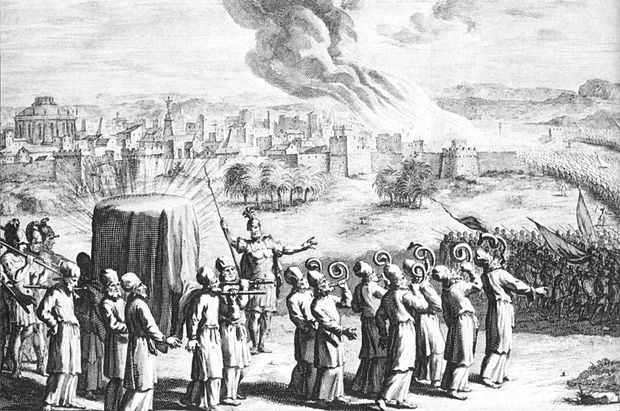 |
| Ark of the Covenant |
The political and cult symbol of Israel before the destruction of the Temple was the Ark of the Covenant. This cult object was constantly found with the Israelites and treasured by them from the time of Moses until the time of the invasion of the Babylonians. It was a rectangular chest made of acacia wood, measuring 4 feet long by 2.5 feet wide by 2.5 feet high.
The Ark was decorated and protected with gold plating and carried by poles inserted in rings at the four lower corners. There was a lid (Hebrew: kipporet, “mercy seat” or “propitiatory”) for the top of the Ark, and perched on top of the monument were two golden angels or cherubs at either end with their wings covering the space over the Ark.
The first interpretations about the Ark were simple: It was simply the repository for the stone tablets of laws that Moses received on Mount Sinai. It was housed in a tent and on pilgrimage alongside the children of Israel in the desert. Ancient peoples would preserve treaties or covenants in such a fashion.
  |
Soon, however, the Ark became charged with deeper latent powers and purposes. For one thing it was the place where the divine being would choose to make some revelation and communication with Israel. Moses would go there for his meetings with God.
So the Ark became more than a receptacle for an agreement; God’s presence filled the Ark. A parallel to this notion is the qubbah, the shrine that Arab nomads carry with them for divination and direction as they search for campsites and water.
In a similar way the Ark was a supernatural protection—called a palladium—that ensured that Israel would never lose in battle. In this sense many Near Eastern cities and nations often had some token of divine protection. Similarly, the Greeks often symbolized their military invincibility through divine emblems such as Athena’s breastplate in Athens and Artemis’s stone in Ephesus
When the Jerusalem temple was built under Solomon, the Ark took on a more complex meaning. It had to take into account the kingdom of David and Solomon, the capital city of Jerusalem, and the rituals of temple and sacrifice. So the Ark became the throne or the divine contact point for God’s rule over the world.
The Ark was no longer housed in a tent; it had its own inner courtroom. The angelic representation over the chest became a divine seat, or at least a footstool. Ancient artistic representations of this concept have been discovered in other cultures of the Fertile Crescent: Human or divine kings are often depicted as sitting on a throne supported by winged creatures.
The Ark disappeared from Jerusalem after the Babylonians
That the Ark could fall into godless hands was considered to be more catastrophic than the destruction of the Temple. Whatever the cause, Josephus said that it was not present in the rebuilt temple of Herod.